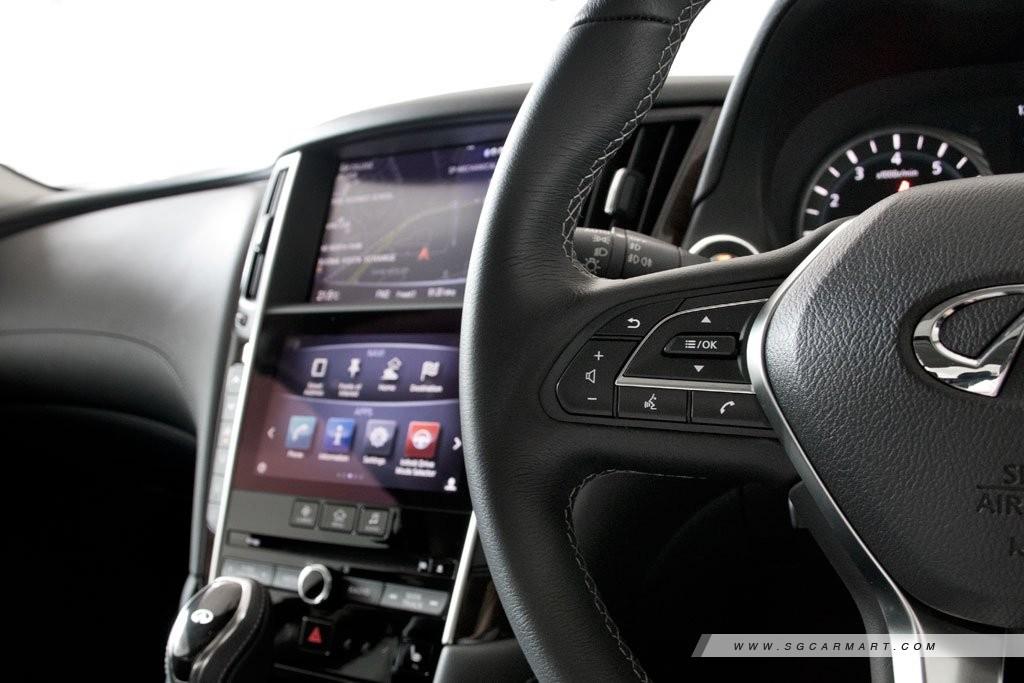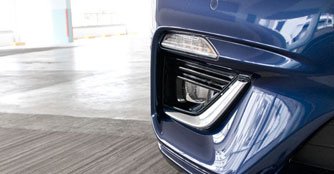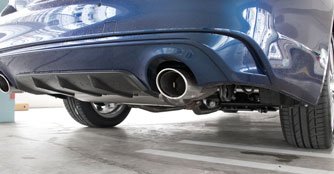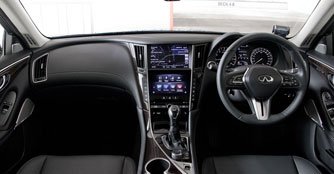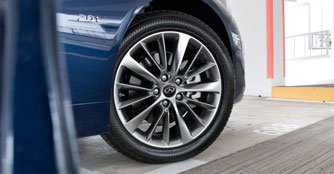Infiniti Q50 2.0T Sensory with ProACTIVE (A) Facelift Review
04 Apr 2018|35,146 views
Facelift (What's New)
Wider grille to enhance presence
Tweaked foglamps with aluminium insert
Modern-looking tailights
The updated Infiniti Q50 is a compact executive sedan that goes head on with cars like the Audi A4, the BMW 3 Series, the Lexus IS200t and the Mercedes-Benz C-Class. And while it's luxurious on multiple fronts, inside and out, it somehow lacks the attention to detail of the Audi, dynamics of the Bimmer, seamlessness of the Lexus and popularity of the Merc.
That's quite a waste because on the outside, the Infiniti is indeed a looker. With an artfully sculpted sheet metal that won't look out of place when parked beside its peers, the car from the luxury arm of Nissan has done well to carve out a design that doesn't look over excessive.
So what are the changes from this facelift then?
Changes are so subtle that you'll need a keen eye to spot the difference. The bumper and taillights have been tweaked, the grille has now grown a tad and foglamps have been reshaped - all to give the Q50 a stronger presence and modernity on the road.
What about the inside?
Not much has changed here since the last time we drove the predecessor back in 2014. The updated Q50 continues to sport a cabin that's lovely to the touch and appealing to the eyes. But it's when you go into the details that you start realising improvements can be done to the car to match up to its peers.
For starters, the dual-screen infotainment that takes centre stage, flanked by two stacks of buttons, is a tad laggy and dated - which is something you wouldn't expect from a luxury Japanese brand, considering carmakers have been improving their infotainment systems of late, with updated and faster software as well as user-friendlier features.
This would also probably explain why the system constantly prompts me that there is a speed camera ahead even when I'm driving around in a multi-storey carpark or within a condominium compound.
That said, the Infiniti does well elsewhere. It is decently and sufficiently spacious, with comfortable and well-supported seats all round. And for a car that faces strong and popular rivals in Singapore, it most certainly excels with its 510 litres of luggage space - trumping the 480-litre boot space in the BMW 3 Series, the Lexus IS200t and the Mercedes-Benz C-Class.
That's quite a waste because on the outside, the Infiniti is indeed a looker. With an artfully sculpted sheet metal that won't look out of place when parked beside its peers, the car from the luxury arm of Nissan has done well to carve out a design that doesn't look over excessive.
So what are the changes from this facelift then?
Changes are so subtle that you'll need a keen eye to spot the difference. The bumper and taillights have been tweaked, the grille has now grown a tad and foglamps have been reshaped - all to give the Q50 a stronger presence and modernity on the road.
What about the inside?
Not much has changed here since the last time we drove the predecessor back in 2014. The updated Q50 continues to sport a cabin that's lovely to the touch and appealing to the eyes. But it's when you go into the details that you start realising improvements can be done to the car to match up to its peers.
For starters, the dual-screen infotainment that takes centre stage, flanked by two stacks of buttons, is a tad laggy and dated - which is something you wouldn't expect from a luxury Japanese brand, considering carmakers have been improving their infotainment systems of late, with updated and faster software as well as user-friendlier features.
This would also probably explain why the system constantly prompts me that there is a speed camera ahead even when I'm driving around in a multi-storey carpark or within a condominium compound.
That said, the Infiniti does well elsewhere. It is decently and sufficiently spacious, with comfortable and well-supported seats all round. And for a car that faces strong and popular rivals in Singapore, it most certainly excels with its 510 litres of luggage space - trumping the 480-litre boot space in the BMW 3 Series, the Lexus IS200t and the Mercedes-Benz C-Class.
Drive it like you mean it
The Infiniti also excels on the road, with its poised behaviour and matured character.
Thanks to its well-weighted steering wheel and taut setup, the Q50 handles itself well as you swing round tighter bends and winding curves energetically. Body roll is kept well in check while the needle-sharp steering allows you to carve corners neatly without having to second guess if you're going to wrap the car round a lamp post.
More excitingly, the very fact that all 208bhp and a generous helping of 350Nm of twisting force are instantly sent to the rear wheel via a seven-speed gearbox means that overtaking slower-moving private-hire vehicles is done more for the 'kick' than the need.
Around town, where civilised driving behaviour is necessary, it is a cinch to pilot the car. Thanks to its compact dimensions, zipping in and out of traffic is as easy and fuss-free as breathing.
Also easy is the car's capability of soaking up all but the biggest bumps and the roughest ruts in its stride, despite its taut setup, without having the need to call up your chiropractor.
Is it worth the consideration, this car?
That's like asking if McDonald's cheeseburger is worth getting over Burger King's double cheeseburger or if the chicken at KFC is tastier than the ones they serve at 4Fingers.
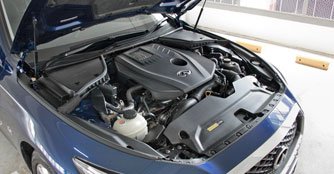
 208bhp and 350Nm of torque from the 2.0-litre turbocharged engine allow the car to finish the century sprint in 7.2 seconds
208bhp and 350Nm of torque from the 2.0-litre turbocharged engine allow the car to finish the century sprint in 7.2 seconds
It's essentially up to you, really, even though the Q50 wouldn't be our first weapon of choice. But is it worth considering? I would say absolutely. At $171,800 (as of 8 March 2018), you'll be getting more performance figures for a more affordable price compared to any of its German peers.
The Infiniti Q50 may lack the attention to detail of the Audi A4, dynamics of the BMW 3 Series, seamlessness of the Lexus IS and popularity of the Mercedes C-Class, but then again, which car is without its flaws?
The Infiniti also excels on the road, with its poised behaviour and matured character.
Thanks to its well-weighted steering wheel and taut setup, the Q50 handles itself well as you swing round tighter bends and winding curves energetically. Body roll is kept well in check while the needle-sharp steering allows you to carve corners neatly without having to second guess if you're going to wrap the car round a lamp post.
More excitingly, the very fact that all 208bhp and a generous helping of 350Nm of twisting force are instantly sent to the rear wheel via a seven-speed gearbox means that overtaking slower-moving private-hire vehicles is done more for the 'kick' than the need.
Around town, where civilised driving behaviour is necessary, it is a cinch to pilot the car. Thanks to its compact dimensions, zipping in and out of traffic is as easy and fuss-free as breathing.
Also easy is the car's capability of soaking up all but the biggest bumps and the roughest ruts in its stride, despite its taut setup, without having the need to call up your chiropractor.
Is it worth the consideration, this car?
That's like asking if McDonald's cheeseburger is worth getting over Burger King's double cheeseburger or if the chicken at KFC is tastier than the ones they serve at 4Fingers.

It's essentially up to you, really, even though the Q50 wouldn't be our first weapon of choice. But is it worth considering? I would say absolutely. At $171,800 (as of 8 March 2018), you'll be getting more performance figures for a more affordable price compared to any of its German peers.
The Infiniti Q50 may lack the attention to detail of the Audi A4, dynamics of the BMW 3 Series, seamlessness of the Lexus IS and popularity of the Mercedes C-Class, but then again, which car is without its flaws?
Facelift (What's New)
Wider grille to enhance presence
Tweaked foglamps with aluminium insert
Modern-looking tailights
The updated Infiniti Q50 is a compact executive sedan that goes head on with cars like the Audi A4, the BMW 3 Series, the Lexus IS200t and the Mercedes-Benz C-Class. And while it's luxurious on multiple fronts, inside and out, it somehow lacks the attention to detail of the Audi, dynamics of the Bimmer, seamlessness of the Lexus and popularity of the Merc.
That's quite a waste because on the outside, the Infiniti is indeed a looker. With an artfully sculpted sheet metal that won't look out of place when parked beside its peers, the car from the luxury arm of Nissan has done well to carve out a design that doesn't look over excessive.
So what are the changes from this facelift then?
Changes are so subtle that you'll need a keen eye to spot the difference. The bumper and taillights have been tweaked, the grille has now grown a tad and foglamps have been reshaped - all to give the Q50 a stronger presence and modernity on the road.
What about the inside?
Not much has changed here since the last time we drove the predecessor back in 2014. The updated Q50 continues to sport a cabin that's lovely to the touch and appealing to the eyes. But it's when you go into the details that you start realising improvements can be done to the car to match up to its peers.
For starters, the dual-screen infotainment that takes centre stage, flanked by two stacks of buttons, is a tad laggy and dated - which is something you wouldn't expect from a luxury Japanese brand, considering carmakers have been improving their infotainment systems of late, with updated and faster software as well as user-friendlier features.
This would also probably explain why the system constantly prompts me that there is a speed camera ahead even when I'm driving around in a multi-storey carpark or within a condominium compound.
That said, the Infiniti does well elsewhere. It is decently and sufficiently spacious, with comfortable and well-supported seats all round. And for a car that faces strong and popular rivals in Singapore, it most certainly excels with its 510 litres of luggage space - trumping the 480-litre boot space in the BMW 3 Series, the Lexus IS200t and the Mercedes-Benz C-Class.
That's quite a waste because on the outside, the Infiniti is indeed a looker. With an artfully sculpted sheet metal that won't look out of place when parked beside its peers, the car from the luxury arm of Nissan has done well to carve out a design that doesn't look over excessive.
So what are the changes from this facelift then?
Changes are so subtle that you'll need a keen eye to spot the difference. The bumper and taillights have been tweaked, the grille has now grown a tad and foglamps have been reshaped - all to give the Q50 a stronger presence and modernity on the road.
What about the inside?
Not much has changed here since the last time we drove the predecessor back in 2014. The updated Q50 continues to sport a cabin that's lovely to the touch and appealing to the eyes. But it's when you go into the details that you start realising improvements can be done to the car to match up to its peers.
For starters, the dual-screen infotainment that takes centre stage, flanked by two stacks of buttons, is a tad laggy and dated - which is something you wouldn't expect from a luxury Japanese brand, considering carmakers have been improving their infotainment systems of late, with updated and faster software as well as user-friendlier features.
This would also probably explain why the system constantly prompts me that there is a speed camera ahead even when I'm driving around in a multi-storey carpark or within a condominium compound.
That said, the Infiniti does well elsewhere. It is decently and sufficiently spacious, with comfortable and well-supported seats all round. And for a car that faces strong and popular rivals in Singapore, it most certainly excels with its 510 litres of luggage space - trumping the 480-litre boot space in the BMW 3 Series, the Lexus IS200t and the Mercedes-Benz C-Class.
Drive it like you mean it
The Infiniti also excels on the road, with its poised behaviour and matured character.
Thanks to its well-weighted steering wheel and taut setup, the Q50 handles itself well as you swing round tighter bends and winding curves energetically. Body roll is kept well in check while the needle-sharp steering allows you to carve corners neatly without having to second guess if you're going to wrap the car round a lamp post.
More excitingly, the very fact that all 208bhp and a generous helping of 350Nm of twisting force are instantly sent to the rear wheel via a seven-speed gearbox means that overtaking slower-moving private-hire vehicles is done more for the 'kick' than the need.
Around town, where civilised driving behaviour is necessary, it is a cinch to pilot the car. Thanks to its compact dimensions, zipping in and out of traffic is as easy and fuss-free as breathing.
Also easy is the car's capability of soaking up all but the biggest bumps and the roughest ruts in its stride, despite its taut setup, without having the need to call up your chiropractor.
Is it worth the consideration, this car?
That's like asking if McDonald's cheeseburger is worth getting over Burger King's double cheeseburger or if the chicken at KFC is tastier than the ones they serve at 4Fingers.

 208bhp and 350Nm of torque from the 2.0-litre turbocharged engine allow the car to finish the century sprint in 7.2 secondsIt's essentially up to you, really, even though the Q50 wouldn't be our first weapon of choice. But is it worth considering? I would say absolutely. At $171,800 (as of 8 March 2018), you'll be getting more performance figures for a more affordable price compared to any of its German peers.
208bhp and 350Nm of torque from the 2.0-litre turbocharged engine allow the car to finish the century sprint in 7.2 secondsIt's essentially up to you, really, even though the Q50 wouldn't be our first weapon of choice. But is it worth considering? I would say absolutely. At $171,800 (as of 8 March 2018), you'll be getting more performance figures for a more affordable price compared to any of its German peers.
The Infiniti Q50 may lack the attention to detail of the Audi A4, dynamics of the BMW 3 Series, seamlessness of the Lexus IS and popularity of the Mercedes C-Class, but then again, which car is without its flaws?
The Infiniti also excels on the road, with its poised behaviour and matured character.
Thanks to its well-weighted steering wheel and taut setup, the Q50 handles itself well as you swing round tighter bends and winding curves energetically. Body roll is kept well in check while the needle-sharp steering allows you to carve corners neatly without having to second guess if you're going to wrap the car round a lamp post.
More excitingly, the very fact that all 208bhp and a generous helping of 350Nm of twisting force are instantly sent to the rear wheel via a seven-speed gearbox means that overtaking slower-moving private-hire vehicles is done more for the 'kick' than the need.
Around town, where civilised driving behaviour is necessary, it is a cinch to pilot the car. Thanks to its compact dimensions, zipping in and out of traffic is as easy and fuss-free as breathing.
Also easy is the car's capability of soaking up all but the biggest bumps and the roughest ruts in its stride, despite its taut setup, without having the need to call up your chiropractor.
Is it worth the consideration, this car?
That's like asking if McDonald's cheeseburger is worth getting over Burger King's double cheeseburger or if the chicken at KFC is tastier than the ones they serve at 4Fingers.

The Infiniti Q50 may lack the attention to detail of the Audi A4, dynamics of the BMW 3 Series, seamlessness of the Lexus IS and popularity of the Mercedes C-Class, but then again, which car is without its flaws?
Also read our comparison article on:
Infiniti Q50 2.0T Sport (A) vs Lexus IS250 2.5 F Sport (A)Car Information
Infiniti Q50 2.0T Sensory with ProACTIVE (A)
CAT B|Petrol|13.6km/L
Horsepower
155kW (208 bhp)
Torque
350 Nm
Acceleration
7.2sec (0-100km /hr)
This model is no longer being sold by local distributor
All Used Infiniti Q50Thank You For Your Subscription.















